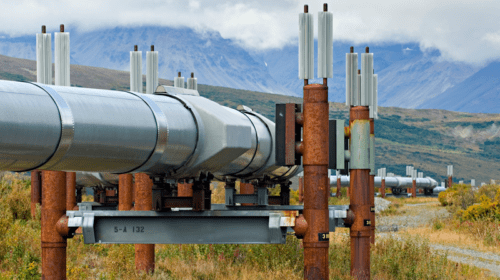Amid all the competitive and political uncertainty generated by the Biden Administration’s plan to curb greenhouse gas emissions and formally engage the United States in the net-zero carbon movement, one thing we know is that oil and gas – and the companies that explore for and produce it – will play a vital role in the U.S. energy future.
Defining exactly what that role will be depends as much on the resolve and wherewithal of individual companies to carve out opportunities in the decarbonization effort as it does on the policies that come from Washington, DC. Another thing we know about the energy business is that more of the biggest names in the hydrocarbon establishment are embracing a net-zero future by investing in renewably produced power and other segments of the electricity value chain. By committing to diversify their business portfolios with lower-carbon assets, giants like bp, Shell, Oxy, ExxonMobil and Chevron are carving out roles for themselves in a still-uncertain energy future.
Granted, it’s not easy for historically oil and gas-focused energy companies to find positives in a plan that envisions electrification and renewable energy ultimately replacing hydrocarbons. But a closer look at the Biden Administration blueprint, and reports such as the Climate Action Framework from the American Petroleum Institute (API) and Net-Zero America from Princeton University (funded by ExxonMobil and BP), reveals opportunities for oil and gas companies to redefine themselves and capitalize on electrification and the move to renewables, without abandoning their core business.
Let’s look at some of the most appealing opportunities and what it will take to maximize them.
1. Take a stake in solar and wind power production and infrastructure. Chevron, through its Chevron Technology Ventures subsidiary, this spring invested in Ocergy, which makes floating offshore wind turbine infrastructure, positioning the company to participate in commercial-scale offshore wind projects. Oil, gas and energy companies are using on-site renewable-power generation to provide a cost-effective alternative to diesel fuel.
Chevron is among a growing number of oil and gas traditionalists to expand into a renewables business that many anticipate is on the brink of a boom. To meet net-zero carbon goals, the Princeton study projects that wind and solar electricity generating capacity would need to grow fourfold during the current decade, enough to supply roughly half of U.S. electricity demand, up from 10 percent today. The need for additional electricity storage and transmission capacity tied to renewable sources also creates opportunities for investment.
Successfully meshing renewable-focused investments and lines of business into an existing oil and gas organization requires a strong yet flexible digital platform, one that enables data and real-time insight to flow unimpeded, so these new ventures integrate seamlessly into the broader enterprise.
2. Invest in hydrogen production and infrastructure. Hydrogen could develop into a $2.5 trillion business by 2050, according to the Hydrogen Council, an organization that counts bp, Total and Shell among its members. The Princeton report sees immense opportunity (and need) to invest in efforts to develop hydrogen as an end fuel and as an industrial feedstock.
Energy companies with oil and gas experience are particularly well-positioned to develop new revenue streams around the H2 molecule, given the commonality between gaseous fuels. With advanced analytics, modeling and other capabilities as part of their digital core, they can explore opportunities around transportation fuels (for fuel cell-powered vehicles), renewable olefins, renewable plastics and other promising hydrogen markets. These digital capabilities also enable companies to model, plan and execute the most efficient approaches to adapt and augment their assets, supply chains, systems and processes to hydrogen.
As hydrogen providers, energy companies also can strengthen business relationships with downstream industrial customers, supplying the likes of steel and cement producers with a clean fuel that enables them to meet emissions requirements as well as corporate sustainability and decarbonization goals.
3. Invest in an electric utility. More historically E&P-focused companies are buying electric utility assets, particularly in Europe, an indication that they see merit in broadening and extending the reach of their energy portfolios into consumer markets.
Deals such as Total SA’s acquisition of Direct Énergie and Shell Petroleum’s purchase of First Utility are fueling a “beyond the barrel” movement among the oil and gas establishment. The goal: reach a wider range of consumers via an integrated electricity supply chain that stretches from generation station to the residential thermostat, similar to the drilling rig-to-fueling station model with petroleum-based fuels. Taking a stake in the electric utility business also opens opportunities to tap emerging retail opportunities. More on that in a moment.
Here again, a strong, scalable digital core could enable a company to seamlessly integrate newly acquired utility assets, providing the connectivity and integration among previously disparate ecosystems. The digital core provides the framework to extend the asset-optimization approaches used at the wellhead to electricity generation and distribution operations.
4. Get closer to the customer. Electric vehicle charging (at home or at a retail station alongside gasoline and diesel), outcome-based energy product and service offerings (built around residential solar equipment, smart thermostats, etc.) are the types of opportunities that could enable historically hydrocarbon-focused companies to find a foothold in emerging “electricentric” consumer markets that show promise.
Consumers today want energy companies to provide them with solutions and a high-quality service experience, not just a commodity. They want energy-efficiency products and services like home EV charging, whole-home monitoring packages with smart thermostats, and home solar options. They also want a bundled experience, where the energy molecule itself is packaged with those products. Using experience management, or XM, tools and data, an energy company can gain a 360-degree perspective on its entire spectrum of customers, so they can tailor the products and services they offer to customer preferences and priorities, and ultimately forge enduring relationships with those customers, whether retail or industrial.
5. Pursue partnerships to share risk. It’s critical that the execs who steer company strategy realize they don’t have to do any of this alone. By partnering with others on ventures related to EV charging, offshore wind, hydrogen infrastructure, etc., they can compete as an entire value chain where they can share risk and leverage the individual strengths of members of that chain.
In the case of EV charging, the Princeton study projects that achieving net-zero carbon emissions by 2050 will require putting roughly 50 million electric cars on the road, along with installing three million or more public charging ports nationwide. While super-majors like Shell and bp build Europe-focused partnerships around EV fast-charging, opportunity knocks for U.S.-focused oil and gas companies to find roles in similar partnerships stateside. The Biden carbon-reduction plan also encourages renewable-focused partnerships like the new Chevron-Toyota alliance to develop large-scale hydrogen-related commercial businesses.
“This opportunity leverages our market position, assets, technology and organizational capability and supports our efforts to help advance a lower-carbon future,” Andy Walz, president of Chevron’s Americas Fuels & Lubricants, said in announcing the Toyota alliance, an acknowledgement that there is indeed real potential for a traditionally hydrocarbon-focused company to prosper in a lower-carbon future.
Benjamin Beberness is global vice president for the oil & gas industry at SAP, where he’s responsible for leading the company’s solution strategy and global marketing within the oil and gas industry.
Oil and gas operations are commonly found in remote locations far from company headquarters. Now, it's possible to monitor pump operations, collate and analyze seismic data, and track employees around the world from almost anywhere. Whether employees are in the office or in the field, the internet and related applications enable a greater multidirectional flow of information – and control – than ever before.






